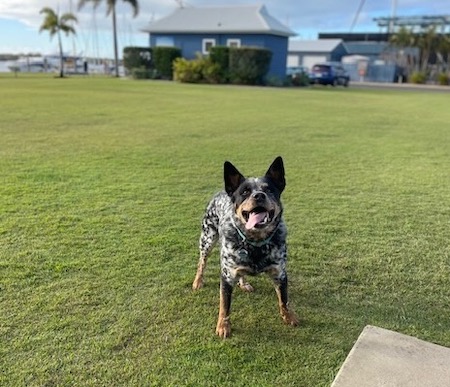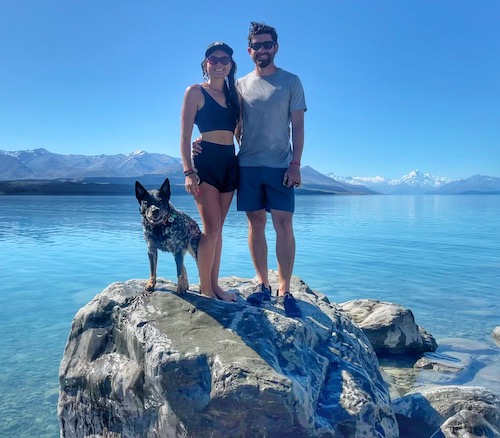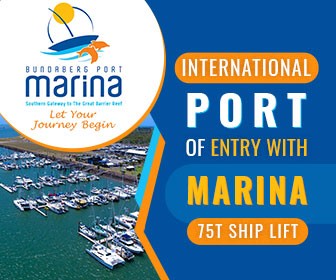South Pacific: The Logistics of Sailing with a Pet
Travelling through the South Pacific with a pet onboard is not the problem that it appeared at the start, according to cruiser Katie Monahan. However, some countries are easier to get into than others and the costs can be substantial, as Katie outlines in this report about her experiences with their dog Logan.
Published 1 year ago
When we first decided to sail around the world, my husband Matt and I basically wrote off New Zealand and Australia from places we would be able to visit. Everyone we spoke to said it was impossible, especially with a dog versus a cat. Like many sailors out there, when faced with a seemingly “impossible” obstacle, I wanted to conquer it.
Looking back, with more time, we could’ve avoided some headaches, but with a limited amount of money in our budget, we couldn’t stay out on the great wide blue forever, at least without a source of income.
French Polynesia and Fiji
We found the process of getting our dog Logan into French Polynesia to be a breeze. However, since we only had a three month visa, we were unable to successfully import him to Fiji (we needed to get there to get a replacement boom).
Fiji can be a difficult place to import a dog if they have not lived in the South Pacific for more than six months and even if they have, you have to get the right people on your side. We spoke to biosecurity and the BAF veterinarians, but there was no way to get around it. Our dog would have to be bonded on board ($1500FJD) for the entirety of our stay.
Being bonded on board meant that we had to have a one week check in with the biosecurity team ($27FJD). We also had to share our position and let them know of all of our movements and plans each week.
If you decide to go to Fiji and are not able to import your pet, I highly suggest not hauling out for maintenance. If you are to haul out, you must put your animal in a quarantine facility for the duration of the haul out.


New Zealand
Now on to New Zealand. Through extensive research and too many emails to count between Biosecurity New Zealand (MPI) and Australia, I discovered you could import your pet into New Zealand with a 10 day minimum quarantine. Then if we are in New Zealand for 180 days (plus quarantine), he could then travel to Australia without quarantine as long as we check out with an approved MPI veterinarian five days or less prior to departure.
Importing cats into New Zealand is a bit easier due to the fact that they don’t require time-sensitive blood tests that must be sent to the United States. If your pet is not successfully imported into Fiji, technically the Fiji Biosecurity vets (BAF) cannot fill out an export certificate, which means the pet would have to stay in quarantine for a longer period.
We worked around this by contacting BAF directly and requesting they sign off on the blood tests. The biggest hurdle if you want to reduce the amount of time in the Quarantine facility is you need to time the tests perfectly with your planned departure.
There are three blood tests you must send off to the United States for testing. These tests must be done 16 and 30 days before departure interestingly, it takes about 20-25 days to get the test back…. Yeah you see where I’m going with this. Our originally “planned” day of departure turned out to be a horrible weather window to transit to New Zealand, so our blood tests “expired” and we had to re do the tests.
On a positive note, when applying for the import permit, there are a few equivalences offered to cruisers—this is why it is imperative to have contact with someone in MPI. I worked with an amazing employee at MPI who is probably sick of me, but she helped a ton through the process.
Here are the equivalences to ask for:
- CTO Direction 2016 057 allows for cats and dogs travelling on yachts to have the six month residency in Category 2 approved countries to be counted from the day after departure from the last unapproved country when the following documentation can be provided:
- Passing rabies titre test result (blood sample taken 3 to 24 months before import); and
- Rabies vaccinations as per category 3 requirements
** You must attach your exit zarpe from Panama (or Mexico, etc—basically whenever you entered the South Pacific) as well so they know when you left Panama for the six months to apply. Since Logan had the test done there and meets requirements, the six month period started when we left Panama.
- CTO Direction 2013 060 gives equivalence for cats and dogs arriving on vessels or exported from Pacific Islands that do not have access to veterinary resources to complete test and treatment requirements, other than rabies requirements, in post-arrival quarantine. This may extend the quarantine period, as animals cannot be released until results are received, and incur additional cost to the importer.
** the problem I had with this was the amount of time added to quarantine. You may be able to get a better answer for a cat. There are some weird dog diseases we had to do blood tests for which would have extended Logan’s stay a few weeks.
We can add an equivalence to the import permit to allow tests and treatments to be done in post-arrival quarantine. Please note that if Biosecurity Fiji will not certify your dog for export from Fiji (usually the case when animals are bonded on board yachts and not imported into Fiji), they cannot accept the heartworm or internal/external parasite treatments because they will not be endorsed by Biosecurity Fiji.
If you want to sail to New Zealand with your pet, you MUST clear in Opua, but your pet can only quarantine in Auckland, so you must pay for a very expensive taxi ride down to Auckland.
Getting your pet into New Zealand is not cheap. Here is the breakdown of expenses:
- Import Application: $140USD
- Blood tests and health check in Fiji: $500USD (We had to repeat this due to weather)
- Auckland Quarantine for 10 days, plus ride from Opua to Auckland: $2,200 USD
- Total: $2840USD (minimum)
Australia
To get into Australia via private sailing vessel, it is easiest from New Zealand. As long as the animal has spent over 180 days (plus quarantine) and had a Leishmania test ($290USD) completed 21 days (or more) after arriving, the import process is fairly easy.
You are required to see an MPI Approved veterinarian five days or less prior to departure. An import permit is not required, only a health certificate. You must contact the port in which you plan to enter. We decided to enter in Bundaberg. This is typically not a port approved for pets, however we were able to submit a request for entrance and were granted approval.
We ran into the issue of weather across the Tasman being variable. The closest MP approved vet was in Albany, just north of Auckland, so we had to rent a car and then drive down to Auckland to get the $330USD Health Certificate, which states the dog has been examined by a MPI vet and received internal and external parasite treatments five days or less prior to departure.
Expense breakdown to enter Australia:
- Leishmania Test: $290 USD
Export Certificate: $330 USD - Total: $620 USD
Entering Australia
When we finally got to Australia it was a very easy processes checking in at Bundaberg. They looked over export form/first port form, took his photo and that was it! However, Biosecurity did ask what we did with Logan’s “waste” once we were within 3nm of shore. Luckily Logan hadn’t pooped so it wasn’t an issue. But I believe they want to make sure you do not toss anything overboard within the 3NM zone.
Everyone was well aware Logan was coming so that was key. They told me about a boat that came in a few weeks ago who did not go through the process and they almost destroyed the dog. They were made to anchor out and quarantine onboard for 12 weeks. They said $30k later, they were able to ship the dog to the USA for quarantine and will bring back to Australia at some point. They were also given a $12k fine. So I think us coming in and doing it correctly was a bit of a relief for the agents!
Katie Monahan
SV Searcher
………………………………
About the Authors
Katie and Matt Monahan and Logan the Blue Heeler set off from Puerto Rico in September 2021 onboard SV Searcher, a 1981 Tayana 42 Vancouver built in Taiwan by Robert Harris. They purchased Searcher in Puerto Rico in December 2020 and gave her a facelift before setting off on their voyage.
Matt served in the Coast Guard for seven years spending his entire career on the water logging over 65,000m throughout the Caribbean and Pacific. Katie spent her career in the nonprofit world, training Service Dogs for Veterans and lived on a Sparksman Stephens Yankee 30 in Tampa Bay. The two met at a Christmas party in St.Petersburg, Florida, where they shared their dream of sailing the world.
Katie got Logan from a cattle ranch in Tennessee at eight weeks old and he quickly adapted to boat life sailing Tampa Bay and the Gulf of Mexico. Since leaving Puerto Rico in 2021, they have sailed to Curaçao, Panama, French Polynesia, Fiji, New Zealand and are currently in Australia. They plan to sail through Indonesia and Thailand before setting across the Indian Ocean for South Africa and ultimately closing the loop in Puerto Rico.


………………………………
The opinions expressed in this article are the author’s own and do not reflect the view of Noonsite.com or World Cruising Club.
………………………………
Noonsite has not independently verified this information.
………………………………
Find out all news, reports, links and comments posted on Noonsite, plus cruising information from around the world, by subscribing to our FREE monthly newsletter. Go to https://www.noonsite.com/newsletter/.
Related to following destinations: Auckland, Australia, Bundaberg, Fiji, French Polynesia, New Zealand, North Island (New Zealand), Opua (Bay of Islands), Queensland
Related to the following Cruising Resources: Cruising Information, Cruising with Pets, Documents, Documents Required, Other Considerations










This is an amazing insight to all that it takes, but knowing it’s possible is fantastic. This was extremly helpful. We’re a few years away from making it to the south pacific and beyond, but glad to know we can bring our lovely dog with us. Fair winds.
Sasha
Thank you for this article! For people considering importing their dog to Fiji after a 6 month+ Pacific stay: we did this successfully by sailing straight from FP to Fiji and complying with all requirements. Unfortunately the official veterinarian told us that our dog was the last dog to be imported by boat for now and that the only way to officially import a dog into Fiji now is by plane. So it seems keeping the dog under bond will be the only option when arriving by boat. On top of that there is a real ‘snitch’ culture in the whole of Fiji, so secretly letting your dog of the boat on a remote beach (what lots of people have told me in the past would be ‘the way’ to cruise the South Pacific small Islands with a dog) can really turn into a very unpleasant situation, costing lots of money (loss of bond + having to pay fines), on top of that they usually throw you out of the country, that is if they do not kill your dog… Not to frighten anyone, but just to be clear 🙂
Regarding the import rules: they change a lot over time. So always contact the proper authority in advance to see what they want from you exactly at the time you ll be going. Hopefully Fiji will change back it’s rules so that sailors will be able to land their dogs again. If you want to contact biosecurity of Fiji, you could email Yogesh Reddy: yreddy@baf.com.fj or call them if you don’t receive a reply: +6793312512.
Happy sailing to all dogs and humans 🙂
Thanks so much for the contact info.